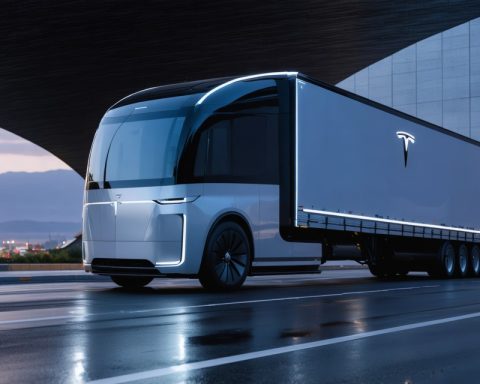Wolfspeed’s Bumpy Journey to Success
Faced with significant challenges and underperformance, Wolfspeed, a pioneering name in silicon carbide (SiC) technology, saw its stock tumble by 85% in 2024. Despite these setbacks, there’s a glimmer of hope on the horizon for this semiconductor innovator, as a new plan is set to increase production and cash flow.
Engineering Solutions for the Future
Renowned for its expertise in wide-bandgap semiconductors, Wolfspeed is instrumental in the development of SiC-based devices like MOSFETs and diodes. With SiC’s impressive ability to handle extreme conditions, Wolfspeed targets emerging sectors such as electric vehicles (EVs) and renewable energy. While competitors operate globally, Wolfspeed’s U.S.-based focus allows it to spearhead a major shift to 200mm wafers, which exceeds the efficiency of the older 150mm technology. With the SiC sector looking to expand significantly, Wolfspeed stands at the forefront.
Significant Investments Spark Future Optimism
A boost to Wolfspeed’s efforts came through a $750 million CHIPS Act incentive alongside a matching investment from key stakeholders, paving the way for expansions in New York and North Carolina. This growth, if fully realized, could elevate Wolfspeed’s annual revenue to $3 billion, marking a pivotal high-growth phase for the company.
Challenges and Predictions
Snapshots from Wolfspeed’s journey reveal struggles with low demand, especially in certain industrial areas, despite promising traction in the EV market. Revenue took a 1% hit in Q1 of fiscal 2025, yet $11 billion in design contracts indicate robust future prospects.
Approaching 2025 cautiously, Wolfspeed faces skepticism from analysts forecasting a 2.2% revenue dip and broader losses. However, projected trends suggest a promising leap in 2026, forecasting revenue to surpass $1.2 billion, underlining potential for investors eyeing the long-term horizon.
Wolfspeed: Navigating the Future of Semiconductors with Innovation and Resilience
Introduction: Wolfspeed’s Emerging Role in Semiconductors
Wolfspeed, a leader in silicon carbide (SiC) technology, is at a critical juncture as it navigates a volatile market landscape. Despite an 85% drop in stock value in 2024, the company’s strategic initiatives in production enhancement and market expansion herald a promising future. As silicon carbide gains traction, Wolfspeed is well-positioned in pivotal growth sectors—electric vehicles (EVs) and renewable energy.
Cutting-Edge Features and Technological Edge
Wolfspeed is instrumental in the advancement of wide-bandgap semiconductor technology, specifically SiC-based devices such as MOSFETs and diodes. SiC materials have superior thermal conductivity and can withstand extreme voltages and temperatures, making them ideal for high-demand applications. Wolfspeed’s strategic pivot to larger 200mm wafers over the traditional 150mm wafers exemplifies its commitment to technological innovation, promising enhanced manufacturing efficiency and performance.
Market Trends and Predictions for SiC Use Cases
The global demand for more efficient and sustainable energy solutions propels SiC as a critical component in EVs and renewable energy systems. Wolfspeed’s U.S.-based operations offer a strategic advantage in this competitive arena. Market trends indicate an expanding SiC sector, with a significant shift towards renewable energy technologies and electrification expected in the coming years. This growth trajectory showcases Wolfspeed’s potential to capitalize on innovative semiconductor solutions.
Financial Insights and Strategic Investments
Underpinning Wolfspeed’s steadfast journey is a robust financial strategy bolstered by a $750 million CHIPS Act incentive. Alongside parallel investments from stakeholders, the company engages in expansion efforts across New York and North Carolina. If these plans are executed successfully, Wolfspeed could see its annual revenue surge to $3 billion, marking a substantial growth phase.
Challenges and Analytical Perspectives
While Wolfspeed faces hurdles, including low demand in certain industrial segments, its foothold in the EV market presents substantial prospects. Despite a 1% decrease in revenue in the first quarter of fiscal 2025 and analyst skepticism predicting a 2.2% revenue decline, Wolfspeed’s extensive $11 billion in design contracts underscore a robust pipeline. Future projections suggest potential revenue exceeding $1.2 billion by 2026, signaling future profitability and growth opportunities.
Conclusion: Prospects and Strategic Positioning
Wolfspeed’s journey exemplifies both the challenges and opportunities within the semiconductor industry. As it navigates market fluctuations and technological advancements, Wolfspeed remains committed to spearheading innovation in silicon carbide technology. For investors and industry stakeholders, Wolfspeed presents a compelling case study of resilience and foresight in the rapidly-evolving semiconductor landscape.
For more information on Wolfspeed’s innovations and market strategies, visit the official Wolfspeed website.








